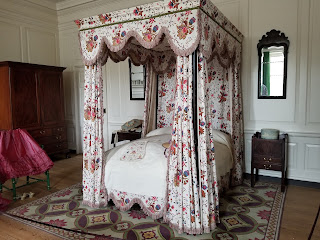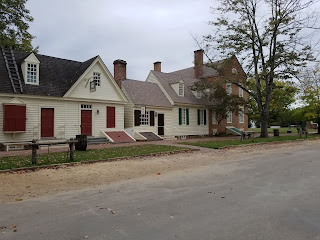# 63 Williamsburg, VA
Hello Williamsburg!
Most National Park visits begin in the Visitors Center.
This relief map gives you a hint the size of this park.
The donor plaques hung on the wall facing the entrance. I found this plaque for those contributing
One Million Dollars and Above interesting.
Once inside the building this group of friends that Jay
found welcome you. Both sides of the
lobby hold large gift shops! Rotating panels give a sampling of what to expect
on your visit today. Williamsburg provides a living community of the 1800s.
The ticket line reminded us of Disneyland. Every ticket taker has a whole spiel to
give. Some, like the one helping Lynn
and Jay take way too long. We later
learned that Williamsburg is a public street and anyone can visit it. So you could walk the streets without paying
the admission price. The drawback is you
cannot enter any of the historical buildings.
Some buildings need special tickets plus the admission ticket to
enter. The park divides into three
districts: Capitol, Market Square and the Palace Green. Each area highlights historic sites to visit,
trade sites staffed by experts who demonstrate or teach a craft, shopping sites
and dining sites. The park closes at
5:30, but offers evening events also. A visitor could spend a great deal of
time here exploring all the facets this park offers.
The community can be reached on foot from the Visitor’s
Center, or you can take the free shuttle.
The first shuttle stop dropped us at the Governor’s
Palace. You are then escorted to a room
with about 25 people and given an overview of the times and the house.
The parlor sits
immediately inside the front door. The
servants pantry would not have been open for guests to see.
Hundreds of weapons artistically decorate the foyer
walls. I didn’t get a good photo of the
main entry, but the blurred print from back by the stairs gives you an idea. The third photo shows weapons hanging above the stairwell. The Governor wanted to impress the those who entered here.
We toured the upstairs bedrooms. The beds appeared to be very short, but I think most people at this time were not as tall as we are today.
A large multipurpose room served as a place for music and
dance and visiting. Dancing and music
held an important part of the culture at these times. Our very knowledgeable guide was explaining
about this room.

Back on the main floor. I think this is his study, and the dining room where he preferred to work.
No respectable palace could be without a powder
room. One does not want a shiny wig!
This coal burning furnace proved expensive to run, since coal had to be shipped in. However like other things in the house, it was to impress.
The ballroom seemed small to me, but since they mainly
danced the minuet which has only one couple moving through two rows of people,
it worked. They could dance it for 5 hours.
the governor's portrait hangs on the second photo, and his wife's is the third photo.
The green room supplied food for the dancers. The ball started in the evening and continued
until about 5 am. This room also had an organ and a harpsichord.
We exited the palace and passed through the part of the garden to the building that housed the kitchen.
The back of the house looked a lot like the front.
The kitchen courtyard complex included a well, a salt house and the scullery.
Next we walked the Palace Green to a main street.
This church still has services.
Some shops remain open to the visitors and some are
closed. A shop displaying the U.S. Flag means
it is open. Some shops show artifacts
from the time, just for display, other shops sell reproductions of those
artifacts.
The round building houses the armory.
The courthouse had just completed a visitor participation panel discussing taxation at the time.
The room with padded chairs were for judges’ discussion. The room with wooden benches were given to the jury. No food or drink, until a decision was made. The last room served as the judge’s chambers.
Jay what did you do to be in the stocks? You might notice that these weren't designed for men over 6 feet tall.
We then market place provided all kinds of colonial type
souvenirs.
We meandered down the main street taking in the sights.
We were headed for the Capitol Building. According to the blurbs this was a must see. We weren't sure if the costumed family were official interpreters or a family getting into the spirit of the day.
This group of Native American interpreters were just stepping out, as was this distinguished man of the community.
We popped into a few shops. The silversmith here sold expensive jewelry.
In the house next door a costumed docent demonstrated embroidery.
This structure the Raleigh Tavern was open for viewing.
We were disappointed that we walk this far and the
Capitol was closed.
We returned to Chowning’s Tavern and dined on some
delicious food.
This home at the end of the street is owned by private
citizens. Just past this house several
blocks were filled with an arts and crafts festival. We took a short peek and headed home.
This pretty site is in the College of William and Mary
area.
Tomorrow we head for the outer banks.


















































































No comments:
Post a Comment